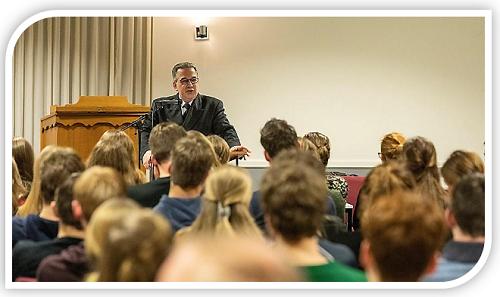Catechesis and Church
Catechesis and Church

Recently I read a book that discussed the isolation of catechesis. Catechetical instruction has become a somewhat lonely experience for many ministers. Every week you will find the minister of the Word spending hours on instructing the youth of the church. But what he does exactly and how things play out there are often hidden from the view of the church.
The church council is somewhat informed. A few times each year some elders will visit the catechism classes, and at the end of the season a report will be handed in by the minister. Perhaps some parents are truly interested in what happens in catechism class, but one can hardly say the same of the church as a whole.
A Concern of the Church⤒🔗
In order to break through the isolation that often characterizes catechetical instruction, it will be good to realize that this work concerns the church. The church has received not only the assignment to preach the gospel, but also the task of teaching all that Christ has commanded (see Matt. 28:19).
Even though office-bearers are charged with these tasks, the church retains its responsibility. Through his apostles, Christ calls the church of all times to preach and to teach.
We speak of the Great Commission of the church, and rightly so. The minister who catechizes is busy carrying out the church’s calling. In catechesis, the church passes on the apostolic doctrine to its youth, in this way leading them into discipleship (see Matt. 28:19).1
As we read the New Testament, it becomes clear that this teaching of the youth cannot be an isolated event. It appears from the New Testament that the entire church is involved in a continuous learning process.2 Again and again, the church itself has to learn certain things. Seen in this way, every member of the church remains a lifelong catechist. A believer never completes their studies.
On the contrary, the New Testament repeatedly speaks of “growing,” “increasing,” “being filled,” “abounding in knowledge” (see Phil. 1:9; Col. 1:9,10; 1 Thess. 3:12; 2 Cor. 8:7). The apostle Paul takes it ill of the Corinthians that he cannot speak of God’s wisdom with them, since they are still acting like children (1 Cor. 2:6ff.). He calls them “infants” who, because of their worldly disposition, cannot tolerate “solid food” (cf. 1 Cor. 3:1ff.).3
The Hebrews are told that they are slow to learn because they still need to be taught the “elementary truths of God’s word” and are not yet ready for the “solid food” that is meant for the “mature” (see Heb. 5:11-14).
Paul points out to the Ephesians that the church must continue to strive for unity in the “knowledge of the Son of God,” becoming “mature” (Eph. 4:13). He tells the Colossians that his work is focused on seeing believers united in love “so that they may have the full riches of complete understanding” (Col. 2:2).
The church has the assignment to teach, but it is also continuously learning (at least, that’s how it should be).
The catechesis of young people takes place within this comprehensive framework. The youth are involved in the great learning process that takes place in the church of Christ. The church is teaching her children, because they need to join her on her way to unity in the knowledge of the Son of God and the full riches of complete understanding.
This teaching from the New Testament makes it clear to us that catechesis cannot and may not be an isolated affair!

The Reformation←⤒🔗
In the age of the Great Reformation, it was well understood that catechesis belongs within the great learning process of the church (the church that teaches and is taught). The education of the youth of the church was by no means an isolated event in which the church as a whole was little or hardly involved.
In Calvin’s Geneva all citizens had to bring their children “au Catechism” at noon on Sundays. The ministers would treat a section of the Catechism, compiled in 1542 by Calvin for this purpose. The children had to recite publicly what they had learned. The adults were also present and learned along with the children. The church order of 1561 states that the instruction of the children had to be done “en presence de l’eglise” (in the presence of the church). For all practical purposes, catechism preaching and catechization went hand in hand.4
In the Dutch refugee church in London, the older children received instruction from the Catechism during the Sunday afternoon service. They recited parts of it, which the minister then explained further in the light of Scripture. The following is noted in the Ordinance of Micron: “By which not only the children, but the entire church, was instructed, taught and encouraged in the various matters of the Christian faith.”5
The Reformed church order of the Palatinate (1563) regulated a catechism service in which young and old received instruction together. The order of this service was as follows: 6
-
Song
-
Prayer
-
Reading of the Law or a summary of the Catechism
-
Instructive discussion by the minister with the children
-
Catechism sermon
-
Examination of the youth in the presence of the church
-
Discussion of the following Catechism questions
-
Prayer
The Reformed churches in our country followed this custom throughout the sixteenth century. There were no separate catechetical classes for children. The church’s education of the youth was fully incorporated into the learning process of the church.
A catechism service was held on Sunday afternoons, generally following this order: 7
-
Scripture reading
-
Reading aloud the questions and answers of the Catechism
-
The catechism sermon
-
The children reciting the questions and answers
Only in the seventeenth century did the church begin to give separate catechism classes to children, especially after the great Synod of Dordrecht (1618-1619) stated that the catechism service is not a suitable means of reaching children.

Still, until the nineteenth century it was customary in catechism services for catechists to recite the part of the Catechism that was being treated in the sermon. It is precisely this concurrence of catechism preaching and instruction to the youth that underlines the fact that the second service on the day of rest had special significance for our forefathers. This service was all about “learning.”8 The instruction to the youth was organized around the catechism sermon. This sermon was the primary means of catechesis for the Reformed churches of the sixteenth century. Through catechism preaching, the church was both learning and teaching. The further instruction of children also took place in close connection with the catechism sermon.
For Consideration←⤒🔗
I think that the Synod of Dordrecht was right. I would therefore not want to argue for a return to the old practice of the sixteenth century. Proper instruction of the youth of the church requires specific action.
But the practice of the sixteenth century certainly illustrates to us to what extent our fathers viewed the teaching of young and old in the church as a unity. The instruction of the youth has its place within the learning process that ought to be taking place in the church of Christ.
The catechesis of our boys and girls is a matter that takes place in the midst of the church. The church is teaching and being taught!
I will add something more to this. By virtue of the covenant in which they are included with their parents, our children are members of the church. Through baptism, they are “incorporated” into the Christian church, as Answer 74 from the Heidelberg Catechism says. 9 This incorporation is an important event. The church stands around the baptismal font and receives a child into her midst. She now also accepts responsibility for this child. This child is now also her child.
This responsibility of the church is expressed in a beautiful way in an old reformational form: “Because these children were baptized today into the fellowship of Christ, I pray through Jesus Christ that you will recognize and consider them as members of our Lord and fellow-members of our assembly. I pray that each one, to the extent that he has the opportunity to do so through Christ, will help these children to be nurtured before the Lord and that, to the praise of Christ, they will be helped by everyone for the good of body and soul.”10
The responsibility that the church accepts at the baptismal font has everything to do with catechesis. The children who have been baptized have become our children. This circumstance should lead the entire church to be involved in what is going on in the catechization. The minister is working with the children of the church! When it becomes a reality to us that teaching and learning are in fact a concern of the church, then we will also start thinking about how we can break through the somewhat isolated position of catechesis. I give a few suggestions for consideration.
First of all, it is important that catechesis will regularly be prayed for during the church service, especially in the beginning of the season.
It also seems desirable to me that the minister provides more information to the church about the catechesis (the groups, the times, the curriculum). This information is not only important for the parents, but for the entire church. Catechesis is the business of the church, and the children are her children. Possibly there could also be a church evening dedicated to catechesis.

I also think it would be very appropriate for a catechist to once again recite the Sunday’s catechism section in the service. It is unfortunate that this old Reformed custom has fallen into disuse.
In this way the catechesis finds its place fully in the centre of the church and the catechists experience: we are learning along with the church. The members surround us. During catechization we are busy with the teaching and confession of the church!
These are only a few suggestions. Anyone who knows of better suggestions should share them. We have already made progress if we have started reflecting on this and if catechesis has found its place again in the life of the church. Something has already been gained when the minister feels less lonely and we realize: the catechesis is something that involves us all!

Add new comment